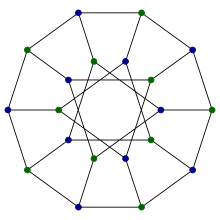Desargues graph
| Desargues graph | |
|---|---|
 |
|
| Named after | Gérard Desargues |
| Vertices | 20 |
| Edges | 30 |
| Radius | 5 |
| Diameter | 5 |
| Girth | 6 |
| Automorphisms | 240 (S5× Z/2Z) |
| Chromatic number | 2 |
| Chromatic index | 3 |
| Genus | 2 |
| Properties |
Cubic Distance-regular Hamiltonian Bipartite Symmetric |
In the mathematical field of graph theory, the Desargues graph is a distance-transitive cubic graph with 20 vertices and 30 edges. It is named after Girard Desargues, arises from several different combinatorial constructions, has a high level of symmetry, is the only known non-planar cubic partial cube, and has been applied in chemical databases.
The name "Desargues graph" has also been used to refer to a ten-vertex graph, the complement of the Petersen graph, which can also be formed as the bipartite half of the 20-vertex Desargues graph.
There are several different ways of constructing the Desargues graph:
The Desargues graph is a symmetric graph: it has symmetries that take any vertex to any other vertex and any edge to any other edge. Its symmetry group has order 240, and is isomorphic to the product of a symmetric group on 5 points with a group of order 2.
One can interpret this product representation of the symmetry group in terms of the constructions of the Desargues graph: the symmetric group on five points is the symmetry group of the Desargues configuration, and the order-2 subgroup swaps the roles of the vertices that represent points of the Desargues configuration and the vertices that represent lines. Alternatively, in terms of the bipartite Kneser graph, the symmetric group on five points acts separately on the two-element and three-element subsets of the five points, and complementation of subsets forms a group of order two that transforms one type of subset into the other. The symmetric group on five points is also the symmetry group of the Petersen graph, and the order-2 subgroup swaps the vertices within each pair of vertices formed in the double cover construction.
The generalized Petersen graph G(n, k) is vertex-transitive if and only if n = 10 and k = 2 or if k2 ≡ ±1 (mod n) and is edge-transitive only in the following seven cases: (n, k) = (4, 1), (5, 2), (8, 3), (10, 2), (10, 3), (12, 5), (24, 5). So the Desargues graph is one of only seven symmetric Generalized Petersen graphs. Among these seven graphs are the cubical graph G(4, 1), the Petersen graph G(5, 2), the Möbius–Kantor graph G(8, 3), the dodecahedral graph G(10, 2) and the Nauru graph G(12, 5).
...
Wikipedia
